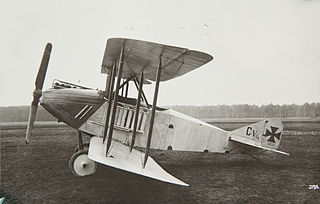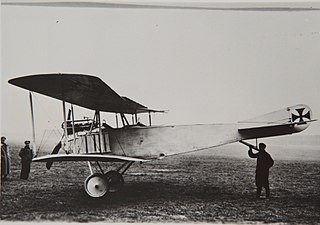
The Dornier Do 12 Libelle III was the third of a line of small German flying boats of the 1930s. It started with the Dornier A Libelle I and the Dornier A Libelle II, though the Do 12 was not a continuation, but an entirely new aircraft.

The AEG B.II was a two-seat biplane reconnaissance aircraft produced in small numbers from 1914. It was a slightly smaller version of the B.I and proved more successful. They were used in limited numbers throughout 1914 to 1915, but were quickly replaced, as they were often derided for lack of speed and armament.

The AEG C.III was a two-seat biplane reconnaissance aircraft, a single prototype of which was built during World War I. The aircraft featured an unusual fuselage design that completely filled the gap between the upper and lower sets of wings, to provide the pilot with improved vision, and to allow the observer a wider field of fire for his 7.92 mm (.312 in) machine gun. The pilot sat to the rear of the observer, who was stationed over the upper wing. This design was not as successful as had been hoped, and the C.III was never entered into service. Despite being heavier than the C.II, its maximum speed increased to 158 km/h (98 mph).

The AEG C.V was a prototype two-seat biplane reconnaissance aircraft of World War I. Designed to use a more powerful engine than previous AEG C-class reconnaissance aircraft, results were disappointing enough that further development was cancelled.
The AEG C.VI was a prototype two-seat biplane reconnaissance aircraft of World War I. It was developed in 1916 from the AEG C.IV, but did not enter production.

The AEG D.I was a biplane fighter of World War I. Three prototypes were ordered, but after the first two were involved in serious crashes, one of which killed flying ace Walter Höhndorf on September 5, 1917, development was cancelled. A triplane version was built as the Dr.I. The second and third prototypes differed little from the first except in detail.

The AEG G.I was a three-seat, twin-engined German biplane bomber aircraft of World War I. It was tested and found to be viable for air-fighting in the latter half of 1915 but performed poorly, necessitating the development of the AEG G.II.

The AEG G.II was a German biplane bomber aircraft of World War I developed from the AEG G.I, with more powerful engines. The G.II was typically armed with three 7.92 mm (.312 in) machine guns and 200 kg (440 lb) of bombs. The bomber suffered stability problems, and many G.IIs were fitted with additional vertical tail surfaces on each side of the fin and rudder to improve flight handling characteristics.

The AEG G.III was a German biplane bomber aircraft of World War I developed from the G.II. Like its predecessor, it was only built in small numbers and saw limited operational use, mainly far from the main fronts of the war.

The AEG G.V was a biplane bomber aircraft of World War I, a further refinement of the AEG G.IV. The type saw limited production before the Armistice, and never entered operational service. It featured a 600 kg (1,320 lb) bombload.

The AEG R.I or Riesenflugzeug 1 was a four-engined biplane bomber aircraft of World War I manufactured by AEG.

The Albatros Al 101 was a 1930s German trainer aircraft. It was a parasol-wing monoplane of conventional configuration, and seated the pilot and instructor in separate, open cockpits.
The DFW R.I,, was a prototype German bomber aircraft of World War I.

The Albatros B.III,, was a German World War I reconnaissance biplane, built by Albatros Flugzeugwerke as the Albatros LDD.

The Arado Ar 77 was a German twin-engined monoplane, designed as an advanced training aircraft from 1934.
The Bautek Bico, also called the BiCo, is a German high-wing, two-place, hang glider designed and produced by Bautek.
The La Mouette Sphinx is a French high-wing, single-place and two-place family of hang gliders, designed and produced by La Mouette of Fontaine-lès-Dijon.

The Albatros L102 / Albatros Al 102, was a German trainer aircraft of the 1930s. It was a parasol-wing landplane, seating the student pilot and instructor in separate, open cockpits. A biplane floatplane version was also built as the Al 102W, with strut-braced lower wings.
The Albatros L 103 / Albatros Al 103 was a German experimental aircraft of the 1930s. It was a parasol-wing landplane of conventional configuration, seating the pilot and flight test observer in separate, open cockpits. The Al 103 was used to test variations in sweepback, dihedral and tailplane area.

The Heinkel HD 14 was a single-engine biplane torpedo aircraft developed by the German aviation company Ernst Heinkel Flugzeugwerke in the 1920s, and produced in a single prototype, under license, from Swedish by Svenska Aero in Stockholm.
















